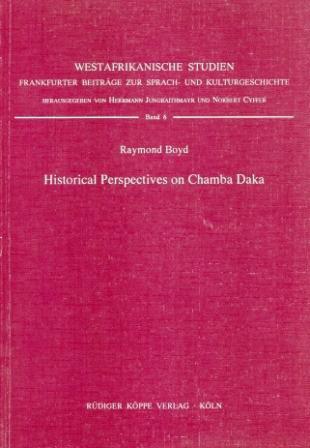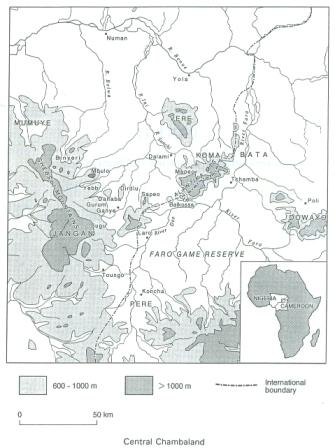



The Chamba are an ethnic group composed of speakers of two quite different languages belonging to the Niger-Congo family. In ethnographic literature, these languages are traditionally called Daka and Leko. Since the speakers of many dialects of both of these languages identify themselves as members of the Chamba ethnic group, they are referred to here as Chamba Daka and Chamba Leko respectively. The name Chamba Daka does not designate a homogenous linguistic unit, but rather a set of dialects whose exact degree of diversity has not yet been precisely determined in every case.
Chambaland, i.e. the central Chamba area, where the majority of the Chamba live, straddles the present border between Nigeria and Cameroon. Chamba Leko speakers are restricted to the easternmost part of the central area, for the most part on the Cameroon part of the modern border. The remainder of the Chamba are Daka-speaking. Greenberg’s classification of Chamba Daka as a member of the Adamawa group of the Niger-Congo family is not uncontested nowadays. Likewise, attempts to group it under the northern branch of the Bantoid languages have proven difficult.
Given the linguistic situation as a whole on the Central African savanna south of Lake Chad, where dozens of quite distantly related languages are packed together, the number and complexity of the changes which have taken place are surely such as to make them unrecoverable by any comparative technique. This is why we must severely limit our expectations in the historical linguistics of these languages and accept that we are much more likely to be able to prove influence than genetic connection.
We are nevertheless faced with the question of where the vocabulary of Chamba Daka does come from. In order to illuminate the similarities between the vocabularies of Chamba Daka and Chamba Leko, this work discusses a list of lexical equivalents which are considered to be loans.
Under these links you will find further descriptions of Adamawa languages:
Ulrich Kleinewillinghöfer in Afrika und Übersee, 78/1995, 305-308
© 2026 by Rüdiger Köppe Verlag – www.koeppe.de